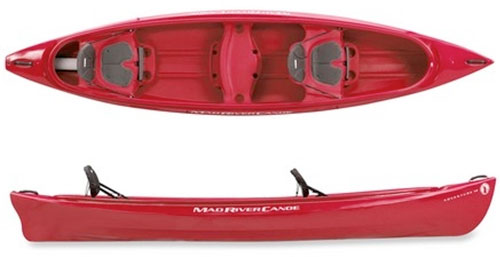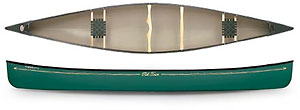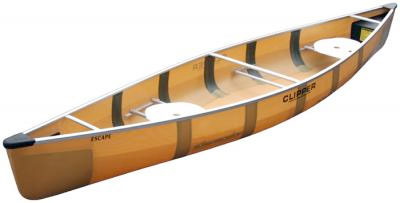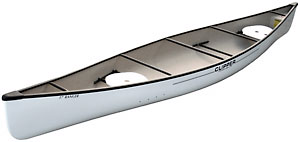From natural birch bark to modern composites, a wide range of materials and constructions are used to build canoes today. Each has its advantages and disadvantages and no one material does it all well. The choice of material, along with canoe shape (which we'll cover in another article), are the result of compromises.
Canoe designers balance material, shape, and cost, with expected use. For example, it's possible to build a very lightweight canoe, but it will be more fragile; a skilled designer would not draw such a canoe with a shape suited to rocky whitewater rivers.
Take into account your paddling use and budget, when considering the different canoe materials available.
Natural Materials
Birch Bark
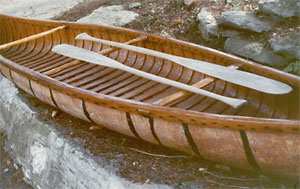
An undated Algonkin birch bark canoe (Image: National Anthropological Archives)
Birch bark is the classic canoe material and it’s still being used to build canoes. Both aboriginal North Americans reconnecting with their culture and other craftsmen still build birch bark canoes by hand.
A birch bark canoe is not just birch bark, but a frame of white cedar ribs and planks covered with birch bark and sewn together with spruce roots.
Though they are often seen hanging in museums, birch bark canoes are still a practical craft. They are lightweight and paddle well. However, they are expensive, fragile, and require constant maintenance.
Pros: Lightweight, paddles well, beautiful to see and use, classic canoe material
Cons: Less durable, requires constant maintenance, very expensive
Best for: Fans of classic craft, with the budget to match
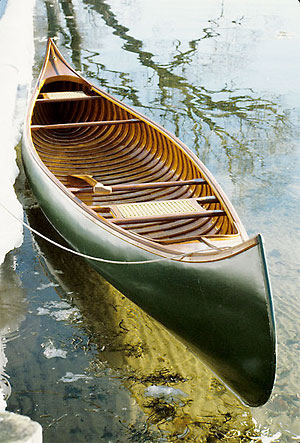
Wood and canvas Morris 16' canoe (Image: Motorrad-67/Wikipedia)
Wood and Canvas
This was the material first used in the late 19th century as a replacement for birch bark. Originally, wood and canvas canoes were built in canoe factories, sometimes producing thousands in a year. Today, though they are still being built, they are produced in limited numbers by a few small companies keeping the tradition alive.
Built in a similar way to birch bark canoes, wood and canvas canoes are made from cedar planks and ribs, with a waterproof canvas skin. They're built on a mold for a standard shape.
Wood and canvas canoes are much more durable than some modern canoeists claim and are easily repaired. They are capable of difficult rivers as well as flat water and are a joy to paddle.
With time, wood and canvas canoes can become quite heavy as water soaks into the wood. Though not as fragile as birch bark canoes, they must be treated with a degree of care that more modern materials don’t require. Though expensive, their price isn’t out of line with the more expensive composite canoes.
Pros: Beautiful to see and paddle, moderate strength
Cons: Moderately heavy, requires routine maintenance, expensive
Best for: Enthusiasts who want a flat water or moderate whitewater canoe of natural materials
Wood Strip
Wood strip canoes, often called “strippers,” are built on a mold and usually have no ribs. They are covered with a plastic resin and usually at least a single layer of fabric to increase their durability. Strippers are usually built by do-it-yourselfers at home.
Though the resin and fabric covering makes these canoes more durable, a puncture in the outer layer will compromise the wood strips and without immediate repair the structure can be permanently compromised.
Wood strip canoes are relatively light. Though mainly useful for flat-water touring, they also are capable of being padded on easy rivers.
Pros: Very beautiful, lightweight, nice shapes possible
Cons: Requires routine maintenance, not suitable for
whitewater, moderately expensive
Best for: Flat-water touring
Wood Planked
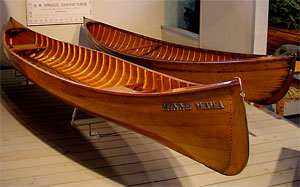
Antique wood planked/stripped canoes in Adirondack Museum. (Image: Mwanner/Wikipedia)
Although these are sometimes called wood strip, they are considerably different than a modern stripper. The method of construction is nearly identical to wood and canvas canoe construction, with the difference being that the planking is fitted tightly with no gaps between the planks, making a final outside layer of canvas unnecessary. They were produced in some numbers in the late 19th and early 20th century. Beautiful, often quite heavy, wood planked canoes were primarily intended for flat water paddling at lodges and resorts.
Pros: Beautiful antique, paddles easily
Cons: Heavy, requires frequent maintenance, not suited to moving water
Skin on Frame
This type of construction has been around for thousands of years for various types of boats from the Welsh coracles to Inuit umiaks. A lightweight frame is covered with a waterproof skin. They can be lightweight. Canoes with this method of construction are quite uncommon and almost always built by a home builder.
Pros: Easy to build by skilled home builder, lightweight
Cons: Very fragile, requires frequent maintenance, construction hinders smooth shape
Folding
Folding canoes have been around since at least the end of the 19th century. Similar to skin on frame, in this method, the skin can be quickly removed and the frame broken down into smaller pieces. Modern folding canoes are moderately durable, capable of white water.
Because they flex more than other more standard canoe materials, folding canoes have a different feel and are not as fast as a similar rigidly constructed canoe. They are often used by expedition canoeists who need a canoe that can be easily carried aboard a small bush plane.
Pros: Lightweight, compact when folded or packed, capable of moderate white water
Cons: Nearly as expensive as a similar composite canoe, slower than a rigid canoe
Modern Materials
Aluminum
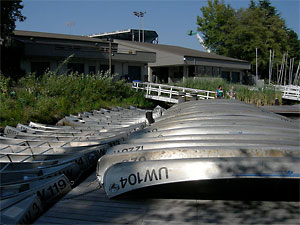
Aluminum canoes lined up at University of Washington. (Image: Joe Mabel)
First utilized as a canoe material after World War II by the Grumman Aircraft Company, aluminum canoes are still being produced, though not in the numbers they once were.
Aluminum is virtually maintenance free and quite rugged. Though used for many years on both flat water and whitewater boats, aluminum has some disadvantages when compared with more modern materials.
Aluminum canoes are constructed in two identical halves riveted together. Because of the manufacturing process, aluminum canoes often have less desirable shapes than canoes built of other materials. While lighter than wood, aluminum is heavier than other modern materials, making it harder to maneuver in the water and harder to portage. Aluminum canoes tend to hang up or stick on rocks, an issue in river and whitewater travel.
Aluminum also is noisy. It will be hot to the touch on sunny days, and will pull heat from your body on cool days. Aluminum canoes usually require floatation bags in moving water, or they will sink if capsized.
Pros: Very durable and strong, little maintenance needed, lighter than wood, medium cost
Cons: Noisy, sticks on rocks, hot surface on sunny days, saps heat from body on cold days, heavier than modern materials, manufacturing process limits complex hull shapes
Best for: Casual recreational paddlers on flat water who want a no-maintenance canoe, some expedition trippers who prefer its durability
Polyethylene
Polyethylene is a type of plastic that is thermo molded, much like Royalex. However, without substantial reinforcement, polyethylene lacks stiffness. Like Royalex, Kevlar, and fiberglass canoes, polyethylene canoes are very slippery, allowing them to slide over rocks easily.
Canoes built from polyethylene are low cost and durable, but also quite heavy. Repair can be more difficult than with Royalex or composite canoes. They can be warped by the sun.
Though similar in many ways to Royalex, the majority of polyethylene canoes being made today don’t have the nice shapes available in Royalex or composite canoes. Many northern outfitters use polyethylene canes as they are inexpensive and durable.
Pros: Very inexpensive, durable
Cons: Heavy, manufacturing process limits shape more than composite canoes, difficult to patch, should be protected from UV exposure
Best for: Casual recreational paddlers and trippers looking for an inexpensive, durable boat
Royalex/ABS
In its standard form, Royalex, along with its lighter weight cousin Royalite, is a very durable and tough material. Though not strictly a composite, it is made of different laminations of ABS (acrylonitrile butadiene styrene) with a foam cell core and a vinyl outer skin. Its cost is on par with fiberglass, and its weight is similar.
Because it is thermoformed in a mold, the shapes possible are not as fine as can be achieved with a composite canoe of fiberglass or other material. Consequently, Royalex canoes tend not to be as fast as many composite canoes, given a similar design. However, their durability and reasonable cost make them the choice for many canoeists, from wilderness trippers to white water fanatics.
Canoe builders specify the number of layers and reinforcements from the Royalex manufacturer, currently Spartech, for different models. This is probably the most ubiquitous canoe material being used today. As with other canoe materials, Royalex is subject to degradation from UV rays, so a protective coating should be applied at least a couple of times a year.
Pros: Durable, easy to patch and repair, good all-around, moderately inexpensive
Cons: Moderately heavy, manufacturing process limits shapes more than composite materials, should be protected from UV exposure.
Best for: Serious whitewater paddlers and all around paddlers
Composites
With composites canoes, fibers are formed in a mold and bonded with resins in a specific layup, or laminate schedule. The layup refers to the specific multiple fabrics that go into building a composite canoe. A layup could include up to seven layers of material (such as fiberglass or Kevlar), along with extra material or foam core added for strength in certain areas.
For example, the first layer usually is the gel coat, which is the color coat and is often brittle if put in too thick. Next, there might be an S Glass, a type of highly-impact resistant fiberglass. Next, could be a layer of Kevlar. Then extra Kevlar at the ends, and perhaps the bottom, for added strength. Spectra, another type of fiber cloth might come next. Then another layer of Kevlar. Finally, a final layer of S Glass.
The laminate schedule also may specify different weaves of the different materials, such as mat, roving, and oxford weaves. The builder also will specify resins depending on the properties of each and how they bond with the materials.
Fiberglass
The earliest type of composite canoe, fiberglass is among the most common materials used today. Fiberglass composites are made from either woven cloth or chopped fibers infused with resin that is either hand laid or sprayed in a mold.
Hand laid models are generally lighter, though consequently slightly more expensive. Fiberglass composites are easily repaired and require little maintenance. Protection from UV rays will increase the life of the canoe substantially. While more suited to flat water, they can be used on easy rivers with some care.
Avoid sprayed fiberglass canoes as they are quite heavy, though very inexpensive.
Pros: Relatively low maintenance, moderately durable, easy to repair, good shapes possible, relatively inexpensive
Cons: Rivaling wood and canvas for weight, less expensive construction (chopper gun) yields questionable strength, can crack on impact, unsuitable for white water above Class 1
Best for: Paddlers on flat water to easy rivers who don't mind a moderate to heavy canoe
Kevlar 49
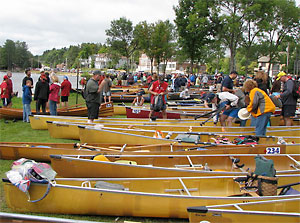
Kevlar racing canoes at the Adirondack Canoe Classic in Saranac Lake, N.Y. (Image: Mwanner/Wikipedia)
Kevlar, developed by Dupont, is light and strong and used in bulletproof vests. However that doesn’t mean you should shoot at a canoe made from this material.
Early all-Kevlar canoes didn’t work out well, as Kevlar is flexible and has no impact resistance. Modern Kevlar canoes usually employ a combination of materials with Kevlar to make a composite canoe that is both strong and light.
How strong and how light? The lighter a composite Kevlar canoe is, the less strength it will have. It is possible to find tandem tripping canoes under 45 pounds, but these are more suited to lake trips with lots of portages than running rivers. Conversely, a tandem composite Kevlar canoe weighing 65 pounds can be a strong boat, light enough to portage but capable of running fast rocky rivers.
Another factor to consider is what other materials are used. Frequently S-glass or Spectra are used in combination with Kevlar to increase strength and impact resistance. Kevlar's maintenance is similar to fiberglass and Royalex.
Pros: Can be very lightweight, durable, good for portages, complex shapes possible, heavier layups are as strong as Royalex
Cons: Expensive, lightweight layups sacrifice strength, should be protected from UV exposure.
Best for: Whitewater paddlers who want a boat with the highest strength-to-weight ratio.
Carbon Fiber
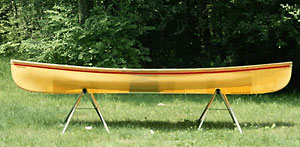
Hornbeck Boat's Ten model is available in Kevlar, carbon fiber and Kevlar, or all carbon fiber layups.
Carbon fiber composite canoes are also being produced. Though light, an all-carbon canoe will be stiff to the point of being brittle. Some canoe models are available in a choice of carbon fiber or carbon fiber with Kevlar layups.
Carbon fiber canoes are quite expensive, at least as much as the higher priced Kevlar composite canoes.
Pros: Lightweight and durable
Cons: Expensive, can be difficult to repair
Inflatable canoes
Also known as I-Cs or rubber duckies, inflatable canoes are more akin to rafts perhaps, than canoes. Identical to I-Ks(inflatable kayaks except for paddles and paddling position), they are outfitted for kneeling with thigh straps. Paddled with a canoe single bladed paddle, they are capable of Class 3 and 4 white water. They can be deflated for easy storage. Because of their design, they are wet, so dry suits or wet suits are recommended in cold water.
Pros: Lightweight, capable of Class 4 white water, durable, moderately inexpensive
Cons: Limited capacity, very slow on flat water, dry suits or wet suits recommended except in warm water conditions
Others
There are a number of brand name materials used in various canoes. For example:
Barracuda is an aluminized glass fabric.
Tuf-weave is an interwoven fabric made of 50 percent polyester and 50 percent fiberglass.
Twin-tex appears to rival Royalex for strength and yet be lighter. Its cost is about the same as Royalex.
Resins
Resins are discussed much less than the materials used in laying up a composite canoe, but resins are a key player and are selected by builders for their different properties. How much and what type of resin used determines how heavy the canoe is, how flexible, and how strong.
Resins originally referred to plant secretions, usually from trees, used as adhesives or varnishes. Now synthetic resins, artificial chemical substance such as a thermosetting plastic, are used.
Different resins have their adherents and the jury is largely still out on the attributes of each. Arguments include how well the resins bond to the material being used and how the resin and composite materials are combined.
For many years there was substantial waste and over-wetting of the materials, which increased the weight of the canoe being built. Currently there are a number of systems being employed by canoe builders to reduce the amount of resin used. These include vacuum bagging in which the molded canoe material is essentially squeezed to push out excess resin, and infusion in which a vacuum is created in the dry materials and a specified amount of resin is injected into them.
GRP
Fiberglass canoes are actually GRP, or glass reinforced plastic. This means that the fiberglass is the reinforcement and the resin is the actual plastic from which the canoe is made.
Epoxy
Epoxy resins are more expensive and harder to work with than polyester resins, but yield greater strength.
Polyester
Polyester resin is the cheapest type of resin used and is commonly found on many fiberglass canoes.
Vinylester
Vinylester resins are sometimes chosen over epoxy and polyester resins because they are thought to bond better with some fabrics. They are arguably as strong as epoxies, and nearly as difficult and expensive to work with. They are more flexible than epoxies, making them less rigid, an advantage in paddling difficult whitewater rivers.
Up next: Canoe Shapes and Curves »

 by Erich Volkstorf
by Erich Volkstorf
